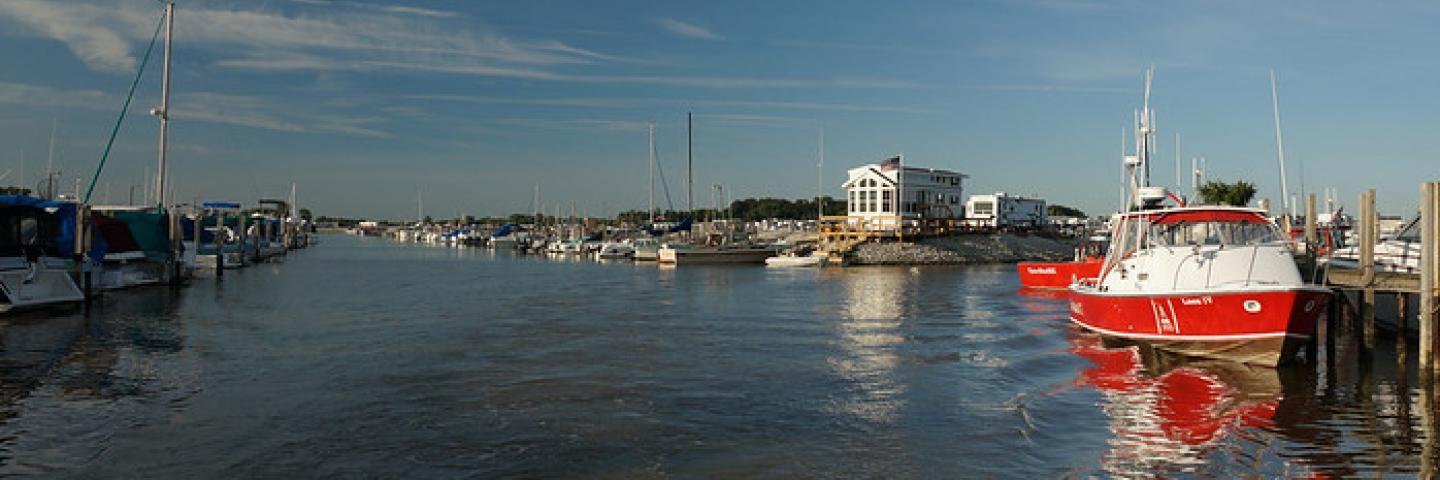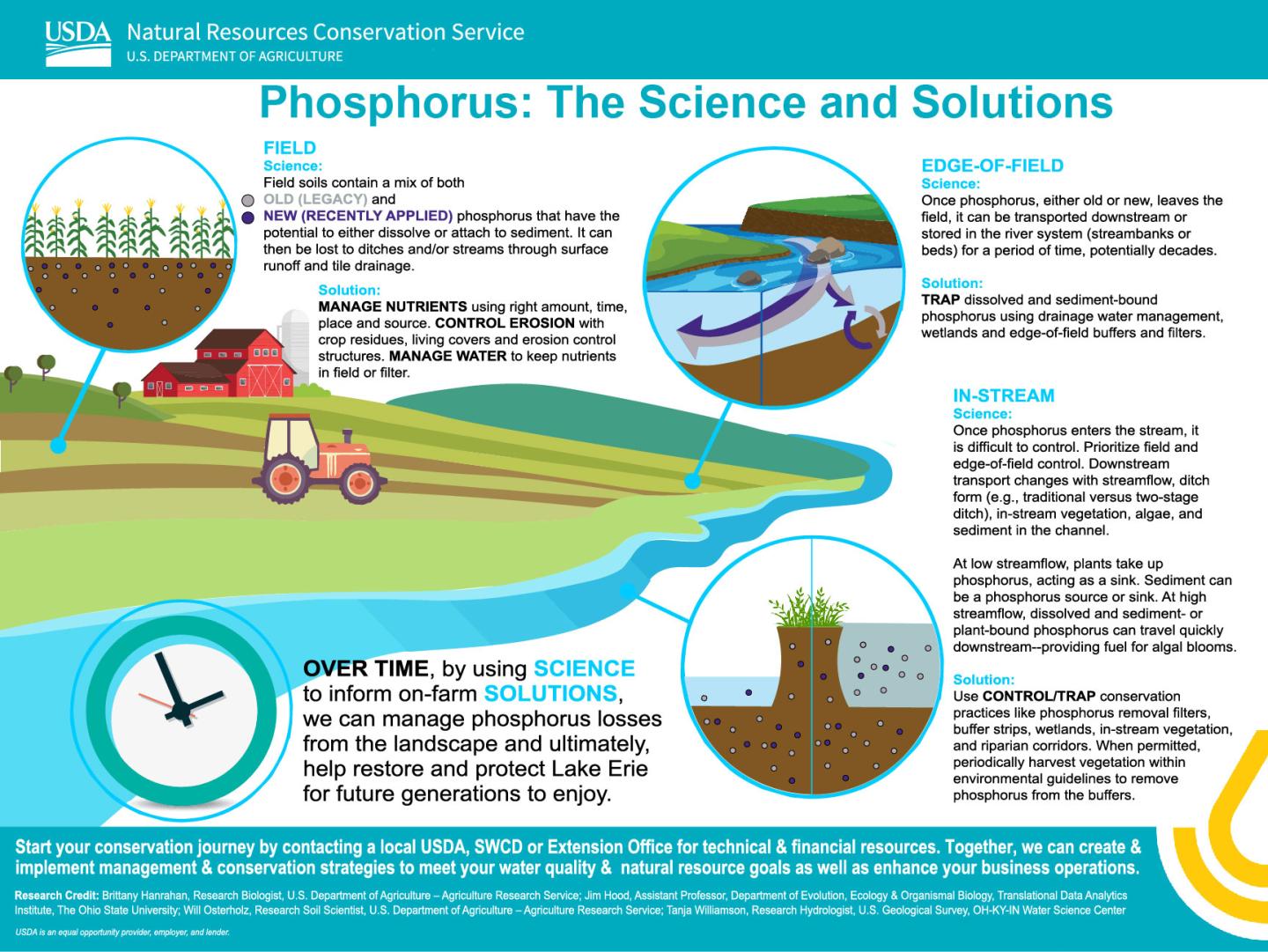
Since 2004, the multi-agency Western Lake Erie Basin partnership has provided strategic funding to improve water quality within the basin, which falls within the states of Ohio, Indiana and Michigan.
Background
America’s Great Lakes, a series of five interconnected bodies of water, contain 21% of Earth’s fresh water, the largest accessible reservoir of fresh water on the planet. Lake Erie, the shallowest of the five Great Lakes, is also one of the most prolific. With seventeen metropolitan areas located in the Lake Erie watershed, demands on the lake include providing access to drinking water, supporting a tourism industry that includes a world class fishery, sustaining the second busiest port in the Great Lakes, and promoting the growth of area commodity crops.
Though a valuable resource, Lake Erie is highly urbanized, industrialized and cultivated. The many demands placed on the lake have impacted its health. Sewage effluent, urban runoff and agricultural sediment loading flow into the lake, where its warm, shallow waters provide ideal conditions for algal blooms to grow and thrive. The blooms, composed of cyanobacteria, can produce toxins that are harmful to humans and animals, threatening Lake Erie’s ecosystem, the region’s drinking water and economic activities.
The Initiative
The United States and Canada have formed a partnership to prioritize the restoration of Lake Erie and the other Great Lakes. As part of that effort, the U.S. Department of Agriculture’s Natural Resources Conservation Service (NRCS), along with five other federal agencies, state and other non-government, industry and academic partners, are dedicated to accelerating Lake Erie’s rehabilitation by reducing phosphorus loading through a number of collaborative projects and initiatives. By providing technical and financial assistance to farmers to implement conservation practices, NRCS can assist in the comprehensive effort to improve water quality, soil health and sustain the region’s economic viability.
Check out the science behind NRCS solutions:

Strategies
This video shows how USDA’s Conservation Effect Assessment Project (CEAP) watershed studies bring partners together to develop science-based solutions and strategically place them where they can deliver the greatest conservation benefits.
In Ohio, Indiana and Michigan, NRCS staff have worked together to coordinate a cohesive approach to restore the Western Lake Erie Basin. A suite of conservation practices focuses on implementing soil health systems, animal waste management/storage, pasture systems and other priorities such as flooding control, erosion mitigation and habitat restoration within the basin. Specific practices include nutrient management, no-till/reduced tillage, cover crops, riparian cover, drainage water management and filter strips.
Progress
Effects of Conservation Practice Adoption on Cultivated Cropland Acres in Western Lake Erie Basin, 2003-06 and 2012
This report quantifies the environmental benefits that farmers and conservation programs currently provide to society, and to explore prospects for attaining additional benefits with further or alternative conservation treatment.
Conservation Practice Adoption on Cultivated Cropland Acres: Effects on Instream Nutrient and Sediment Dynamics and Delivery in Western Lake Erie Basin, 2003-06 and 2012
This report complements the Effects of Conservation Practice Adoption on Cultivated Cropland Acres in Western Lake Erie Basin but focuses on assessing the impacts of those edge-of-field impacts at the watershed scale (4-digit HUC), with consideration of watershed and instream processes.
Blanchard River Demonstrations Farm 2020 Report
After five years, the Blanchard River Demonstration Farm Network, launched in 2015 by the Ohio Farm Bureau Federation and U.S. Department of Agriculture Natural Resources Conservation Service (NRCS), stands as a testament to the collaborative efforts of Ohio’s producers, researchers and supporting federal, state and local partners to improve water quality within the state. The three farms were selected to represent typical Ohio agricultural operations in the Western Lake Erie Basin. A variety of NRCS conservation practices were implemented to address site-specific resource concerns and management objectives. These practices were monitored for effectiveness in improving water quality, playing an important role in helping producers understand the benefits of conservation practices on the land and in achieving land management objectives.
590 Nutrient Management Standard
The Nutrient Management Standard (Code 590) is used to manage rate, source, placement and timing of plant nutrients and soil amendments while reducing environmental impacts. Conservation planners can use this practice on all fields where plant nutrients (commercial fertilizer and/or manures) are applied.
Edge of Field Project Update 2021
Edge-of-field research focuses on monitoring, identifying and reducing agricultural nutrient loss, which can impact the health of streams, rivers and lakes. The USDA’s Natural Resources Conservation Service (NRCS), Agricultural Research Service (ARS) and other partners utilize edge-of-field research to measure the quantity and quality of agricultural runoff to evaluate the overall effectiveness of conservation practices that aim to reduce sediment and nutrient loss. By partnering with researchers, producers provide important insight on how conservation practices interface with farm activity. This data plays a critical role in informing producers on how to apply impactful conservation practices on their land, responsibly managing natural resources and ensuring the commercial viability of their operations.
NRCS Historical Timeline Documents
Since 2004, the multi-agency Western Lake Erie Basin partnership has provided strategic funding to improve water quality within the basin.
2005 Western Lake Erie Basin Water Resources Protection Plan: Ohio, Indiana and Michigan
This project aims to protect and preserve the water resources of the Western Lake Erie Basin. By initiating a cooperative watershed planning process, both short and long-term water conservation needs in the basin can be met. Numerous Farm Bill programs as well as other Federal, State, local and nonprofit programs are available to assist basin landowners to adopt these conservation practices.
2005-2009 Rapid Watershed Assessments
One of the first things NRCS did for the WLEB partnership was to complete a watershed assessment for the 8 Digit HUC units in the Western Basin. The summary indicated a need for both conservation practice funding and technical assistance. NRCS allocated $3.5 million to local SWCDs in the basin to hire more conservationists, who work with farmers to promote and install water quality practices on farms in the basin.
Packard Project Impacting 2013 Farm Bill Initiatives for WLEB
The Lake Erie Stewardship Engagement Initiative hosted three Farm Bill Conservation Program forums focused on the Western Lake Erie Basin. These were held between August 2012 through August 2013. The forums brought together a select group of agricultural producers and conservation partners to identify priorities and solicit recommendations for improvement of USDA Farm Bill conservation programs. The substantive focus for this engagement was agriculture’s impact on water quality in Lake Erie and its tributaries, and the effectiveness of USDA’s conservation programs addressing the impact.
WLEB Initiative, FY 2016 - 2021
A three-year, $41 million investment to target, expand, and accelerate conservation solutions by assessing the current conditions of an agricultural operation, outlining the actions that will have the greatest impact on nutrient and sediment reduction, and estimating the expected environmental benefits.

